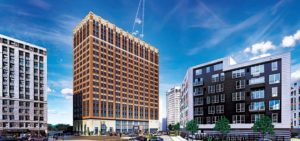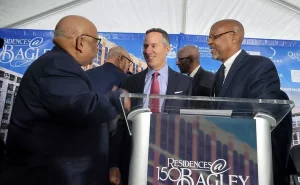Black-led Development Group Kicks Off $75 Million Renovation of United Artists Building
April 1, 2022March 31, 2022
Arielle Kass

The redeveloped 96-year-old United Artists building near Grand Circus Park in Detroit will be called Residences @ 150 Bagley.
Every Wednesday for six years, Tom Goss was on the phone with a group of developers who wanted to remake the long-vacant United Artists building near Grand Circus Park into apartments and retail.
It didn’t matter if he was on vacation, or if there hadn’t been much progress on the slow-moving project.
“It calls you,” Goss said of the system that had been set up. “There was always something to say. We always had something.”
The development took far longer than the two or three years that Goss, a partner at Bagley Development Group, expected. But he said that despite financing and other obstacles that extended the planning part of the project, “the majority of the group kept believing.”
Thursday, their belief paid off. The project, which will be known as the Residences @ 150 Bagley, finally broke ground. Goss said it should be completed by the end of 2023.
The $75 million project will remake the 96-year-old high-rise designed by Detroit architect C. Howard Crane into 148 apartments, 30 of which will be affordable for residents making 80 percent of the area median income — $44,800 for an individual.
It will also include about 10,000 square feet of retail and dining space along Bagley Street. The Ilitch family’s Olympia Development of Michigan owns the United Artists property through an affiliate.

Developer Emmett Moten (left) chats with Chris Ilitch and Butch Hollowell at the Residences @ 150 Bagley groundbreaking event at the United Artists building in Detroit on Thursday.
Keith Bradford, the senior vice president of District Detroit and Olympia Development, said he was “ecstatic” that the project was finally moving forward.
A remake of the building was announced in May 2017 as part of the 50-block District Detroit area downtown that dates back to 2014. While some of the projects in the area controlled by the Ilitch family have moved forward, others have taken longer than anticipated.
Bradford said with the opening of The Eddystone apartments and plans for the Henry Street apartments moving forward — almost 200 units, with some of them available to renters at 40 to 60 percent of the area median income, he said — affordable housing remains a “critical component” of the district.
Other projects in that area include the new Little Caesars’ corporate headquarters, the renovation of the historic Women’s City Club building and the recently announced Detroit Center for Innovation being built in partnership with Stephen Ross’ Related Cos. and the University of Michigan. That project will hopefully break ground in the next two or three years, he said.
Chris Ilitch, president and CEO of Ilitch Holdings, said the United Artists work would “breathe life back into a historic landmark and revitalize an important area for our community.” The district is on its way, he said, to becoming the live-work-play destination “we all want it to be.”
“Detroit is on the rise,” he said, “coming out of the pandemic with new ideas and creative partnerships like this, and fresh possibilities for community-minded development as we see here today.”
The United Artists building was one of 12 decrepit buildings that Detroit Mayor Mike Duggan said he had long had his eye on as being the basis for the city’s reputation as a hub of ruin. He said he was pleased the 18-story building, which has been vacant for decades, would not have to be torn down, unlike some of the others that made his list. This building had been maintained, he said, and the work of Bagley Development Group would bring it back to life.
“This is going to be something big,” Duggan said. “If anybody could pull this off, it’s these guys.”
The members of Bagley Development Group — Goss, Emmett Moten, Scott Allen, Larry Brinker Sr., Richard Hosey, Roy Roberts and Jim Thrower — include some of the best-known names among Black developers and businesspeople. They have helped save a variety of historic buildings in Detroit, including the Fort Shelby Hotel and the Farwell and Capitol Park buildings. The $134 million conversion of the Fisher Body 21 plant near the I-75/I-94 interchange, as 433 apartments, retail, commercial and co-working space, is also being headed by two members of the group.
“To see six African Americans standing together for a project like this creates a sense of believability that we can do more,” said John Graves, a spokesperson for the Bagley Development Group. “I think it will have a continued ripple effect.”
Duggan and Ilitch said they agreed that it was important for the community to see Black developers taking a prominent role in this project and in the city. City Council member Coleman A. Young II said their work brought to mind his father’s adage to lift while you climb. The project will improve people’s lives and provide homes, he said, helping make the city more inclusive. Just as importantly, the groundbreaking after years of discussion shows that “when we say something, we mean it.”
“That’s what this represents,” Young said.
Goss, who has short hair, joked that he had a large afro when the project began.
Many of the delays were caused by financing challenges, then by the pandemic and rising costs. The bulk of the funding came from the U.S. Department of Housing and Urban Development, which provided a $43 million loan backed by the government that the developers will have 40 years to pay back. The federal loan has a lower interest rate and the developers won’t be on the hook personally if anything goes amiss with the project, said Michael Polsinelli, the Detroit field director for HUD. He said it’s taken two or three years for that piece of the financing to be completed; the developers were required to tear down the United Artists movie theater that was part of the original building to provide parking for the project before it could move forward, he said.
Other funding came from the Downtown Development Authority, which provided $8.5 million; the Michigan Strategic Fund, which put up $7 million; and the Detroit Housing and Revitalization Department, which used $3 million in federal Community Development Block Grant funding.
Polsinelli said he would like to see other buildings on that stretch “follow suit.”
“It’s always been something I’ve been interested in seeing happen,” Polsinelli said of the United Artists project. “It’s great that we can be part of the resurgence of Detroit.”
The building will have one- and two-bedroom units as large as 1,300 square feet. Market rates have not yet been set.
Financing partners include AFL-CIO Housing Investment Trust, Gershman Investment Corp, Stonehenge Capital, Bernard Financial Group, Capital Impact and Liberty Bank. Detroit-based Brinker/Christman is the project’s construction manager, HPM is the owner’s representative and Michigan-based Hobbs + Black is the project’s architect.
Moten, the managing partner of Bagley Development Group, describing the challenges with financing and other pieces, said the project was not as easy and quick as he had hoped. But it will be rewarding.
“It was a journey, a hard journey, but a collective journey,” Moten said. “It’s like crawling on broken bottle glass. You’ve got razor wire over you. As you go through, they’re shooting over your head. … If you move your hand to the left, a gator or a croc might get you. If you move your hand to the right, a rhino or an elephant might step on it. Anyone can go back, and say, ‘I quit.’ But if you keep going, all of a sudden, the sun comes out. Now, you’re bloodied. You’re beat up. It’s taken you a long time. But 40 years, nonrecourse. Think about that.”
